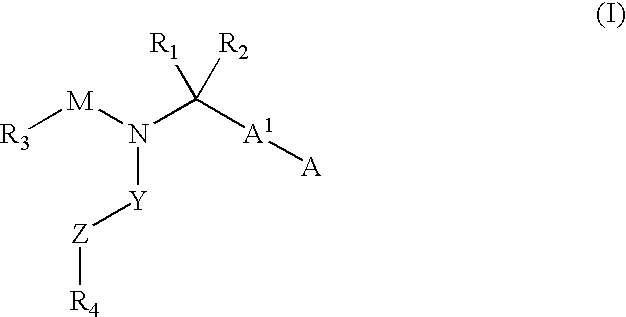Compounds and methods for the treatment or prevention of Flavivirus infections
a technology applied in the field of compound and flavivirus infection treatment or prevention, can solve the problem of blood contamination with hcv
- Summary
- Abstract
- Description
- Claims
- Application Information
AI Technical Summary
Problems solved by technology
Method used
Image
Examples
example 1
2-{(2,4-Dichloro-benzoyl)-[3-(3,5-difluoro-phenyl)-thiophen-2-ylmethyl]-amino}-3-phenyl-propionic acid compound #154
Step I
[0445]2-[(3-Bromo-thiophen-2-ylmethyl)-amino]-3-phenyl-propionic acid tert-butyl ester
[0446]To a stirred solution of 2-Amino-3-phenyl-propionic acid tert-butyl ester (50.6 mg, 0.229 mmol) in ethanol (1 mL), were added 3-Bromo-thiophene-2-carbaldehyde (50 mg, 0.208 mmol.) and acetic acid (21 μL). The reaction mixture was stirred at room temperature under nitrogen for 2 hrs as the progress of imine formation was monitored by TLC. Then, sodium cyanoborohydride (20 mg, 0.312 mmol) was added. The mixture was acidified with sodium bicarbonate and then extracted with dichloromethane. After removal of the solvent, the crude product was purified by silica plate (hexane / ethylacetate 90%:10%) to give 2-[(3-Bromo-thiophen-2-ylmethyl)-amino]-3-phenyl-propionic acid tert-butyl ester in 80% yield: 1H NMR (Varian 400 MHz, CDCl3) δ7.23 (m, 6H, ArH), 6.90 (d, 1H, J=5.3 Hz, thioph...
example 2
2-[(4-Benzofuran-2-yl-benzyl)-(4-methoxy-2,3,6-trimethyl-benzenesulfonyl)-amino]-3-phenyl-propionic acid Compound #5
Step I
[0455]2-(4-Methoxy-2,3,6-trimethyl-benzenesulfonylamino)-3-phenyl-propionic acid methyl ester
[0456]A solution of L-phenylalanine methyl ester (300 mg, 1.68 mmol) in anhydrous CH2Cl2 (10 mL) was cooled to 0° C. in an ice bath, then triethylamine (0.35 mL), 4-methoxy-2,3,6-trimethyl-benzenesulfonyl chloride (438 mg, 1.76 mmol) and catalytic amount of DMAP (25 mg) were added under a N2 atmosphere. The reaction mixture was stirred at room temperature for 12 h. After that period of time, the mixture was partitioned between water and CH2Cl2, the organic layer was separated, dried (Na2SO4) and concentrated. The residue was purified by silica gel column chromatography using ethyl acetate and hexane (1:2) as eluent to obtain 2-(4-Methoxy-2,3,6-trimethyl-benzenesulfonylamino)-3-phenyl-propionic acid methyl ester as a white solid, 500 mg (77%). 1H NMR (CDCl3, 400 MHz): δ7....
example 3
2-[(2,4-dichloro-benzoyl)-prop-2-ynyl-amino]-3-phenyl-propionic acid compound #111
[0471]
Step I
2-[(4-Methoxy-2,3,6-trimethyl-benzenesulfonyl)-prop-2-ynyl-amino]-3-phenyl-propionic acid methyl ester
[0472]A DMF (8 mL) solution of 2-(4-Methoxy-2,3,6-trimethyl-benzenesulfonylamino)-3-phenyl-propionic acid methyl ester (prepared according to example 2, step I) (200 mg) was cooled to 0° C. and then propargyl bromide (80%, 0.07 mL, 0.61 mmol) and Cs2CO3 (200 mg, 0.61 mmol) were added under an atmosphere of N2. The ice bath was removed and the reaction mixture was stirred at room temperature for 12 h. The mixture was partitioned between ether and water, the ether layer was separated, dried (Na2SO4) and concentrated. The residue was purified by silica gel column chromatography using ethyl acetate and hexane (1:3) as eluent to obtain 2-[(4-Methoxy-2,3,6-trimethyl-benzenesulfonyl)-prop-2-ynyl-amino]-3-phenyl-propionic acid methyl ester (185 mg, 85%) as a solid. 1H NMR (CDCl3, 400 MHz): δ7.20-7...
PUM
| Property | Measurement | Unit |
|---|---|---|
| diameter | aaaaa | aaaaa |
| volume | aaaaa | aaaaa |
| pH | aaaaa | aaaaa |
Abstract
Description
Claims
Application Information
 Login to View More
Login to View More - R&D
- Intellectual Property
- Life Sciences
- Materials
- Tech Scout
- Unparalleled Data Quality
- Higher Quality Content
- 60% Fewer Hallucinations
Browse by: Latest US Patents, China's latest patents, Technical Efficacy Thesaurus, Application Domain, Technology Topic, Popular Technical Reports.
© 2025 PatSnap. All rights reserved.Legal|Privacy policy|Modern Slavery Act Transparency Statement|Sitemap|About US| Contact US: help@patsnap.com



